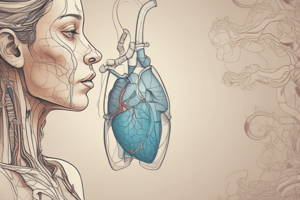Podcast
Questions and Answers
What is the primary chemical stimulus for breathing?
What is the primary chemical stimulus for breathing?
- Carbon dioxide (correct)
- Hemoglobin
- Nitrogen
- Oxygen
Surfactant in the lungs is produced by which type of cells?
Surfactant in the lungs is produced by which type of cells?
- Macrophages
- Type I alveolar cells
- Ciliated epithelial cells
- Type II alveolar cells (correct)
Hyperventilation can lead to which of the following conditions?
Hyperventilation can lead to which of the following conditions?
- Hypoxemia
- Respiratory alkalosis (correct)
- Hypercapnia
- Respiratory acidosis
In a healthy person, the partial pressure of oxygen (PaO₂) is highest in the:
In a healthy person, the partial pressure of oxygen (PaO₂) is highest in the:
The oxygen-hemoglobin dissociation curve shifts to the right in response to:
The oxygen-hemoglobin dissociation curve shifts to the right in response to:
Which of the following structures is the primary site of gas exchange in the lungs?
Which of the following structures is the primary site of gas exchange in the lungs?
The partial pressure of oxygen (PaO₂) in arterial blood is normally around:
The partial pressure of oxygen (PaO₂) in arterial blood is normally around:
The majority of carbon dioxide (CO₂) in the blood is transported as:
The majority of carbon dioxide (CO₂) in the blood is transported as:
Which of the following muscles is most important for quiet, relaxed inspiration?
Which of the following muscles is most important for quiet, relaxed inspiration?
Which law describes the inverse relationship between volume and pressure in the lungs during respiration?
Which law describes the inverse relationship between volume and pressure in the lungs during respiration?
The respiratory control center, which regulates the rate and depth of breathing, is located in the:
The respiratory control center, which regulates the rate and depth of breathing, is located in the:
Which structure prevents food and liquids from entering the airway during swallowing?
Which structure prevents food and liquids from entering the airway during swallowing?
Which of the following best describes tidal volume?
Which of the following best describes tidal volume?
Flashcards
Breathing stimulus
Breathing stimulus
The concentration of carbon dioxide in the blood primarily triggers breathing.
Lung surfactant cells
Lung surfactant cells
Type II alveolar cells produce surfactant in the lungs.
Hyperventilation effect
Hyperventilation effect
Hyperventilation leads to respiratory alkalosis.
Highest PaO2 location
Highest PaO2 location
Signup and view all the flashcards
Vital capacity definition
Vital capacity definition
Signup and view all the flashcards
Primary site of gas exchange in lungs
Primary site of gas exchange in lungs
Signup and view all the flashcards
Normal PaO₂ level
Normal PaO₂ level
Signup and view all the flashcards
CO₂ transport in blood
CO₂ transport in blood
Signup and view all the flashcards
Quiet inspiration muscle
Quiet inspiration muscle
Signup and view all the flashcards
Respiratory volume & pressure
Respiratory volume & pressure
Signup and view all the flashcards
Respiratory control center location
Respiratory control center location
Signup and view all the flashcards
Exercise breathing stimulus
Exercise breathing stimulus
Signup and view all the flashcards
Residual volume
Residual volume
Signup and view all the flashcards
Study Notes
Respiratory System: Key Concepts
-
Primary Site of Gas Exchange: Alveoli are the primary sites of gas exchange in the lungs.
-
Arterial Blood Oxygen Partial Pressure (PaO₂): Normal PaO₂ is approximately 100 mmHg.
-
Carbon Dioxide Transport: The majority of CO₂ in the blood is transported as bicarbonate ions.
-
Quiet Inspiration Muscle: The diaphragm is the primary muscle for quiet, relaxed inspiration.
-
Respiratory Pressure-Volume Relationship: Boyle's Law describes the inverse relationship between volume and pressure in the lungs during breathing.
-
Respiratory Control Center: The medulla oblongata houses the respiratory control center, regulating breathing rate and depth.
-
Exercise-Induced Breathing Stimulation: Increased carbon dioxide levels and decreased pH in the blood stimulate faster breathing during exercise.
-
Residual Volume: Residual volume represents the air remaining in the lungs after maximum expiration.
-
Swallowing Protection: The epiglottis prevents food and liquids from entering the airway during swallowing.
-
Pulmonary Stiffness/Scarring: Pulmonary fibrosis is a condition where lung expansion is reduced due to stiffness or scarring.
-
Tidal Volume: Tidal volume is the volume of air inhaled or exhaled in a normal breath.
-
Oxygen-Hemoglobin Binding Influence: The partial pressure of oxygen (PaO₂) significantly influences oxygen binding to hemoglobin.
-
Upper Respiratory Tract Components: The nasal cavity, pharynx, and larynx are part of the upper respiratory tract; the trachea is part of the lower respiratory tract.
-
Primary Breathing Stimulus: The concentration of carbon dioxide is the primary chemical stimulus for breathing.
-
Surfactant Production: Type II alveolar cells produce surfactant in the lungs.
-
Hyperventilation Effects: Hyperventilation can lead to respiratory alkalosis.
-
Highest PaO₂ Location: Alveoli have the highest PaO₂.
-
Maximum Expiration Volume: The vital capacity represents the maximum volume of air that can be exhaled after a maximum inhalation.
-
Bronchial Inflammation: Chronic bronchitis is characterized by inflammation of the bronchi, causing cough and mucus.
-
Oxygen-Hemoglobin Dissociation Shift: The oxygen-hemoglobin dissociation curve shifts to the right with increased levels of carbon dioxide and decreased pH.
Studying That Suits You
Use AI to generate personalized quizzes and flashcards to suit your learning preferences.




